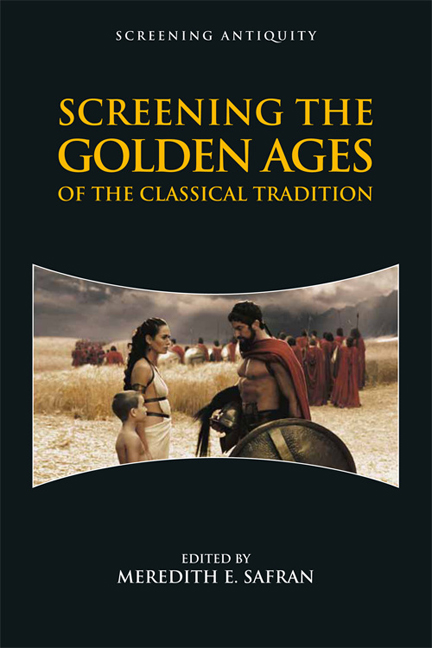Book contents
- Frontmatter
- Contents
- Series Editors’ Preface
- Editor's Acknowledgments
- Contributors
- Illustrations
- Abbreviations
- Introduction: Searching for Gold in an Age of Iron
- PART I THE GLORY THAT WAS GREECE
- PART II THE GRANDEUR THAT WAS ROME
- 8 “All That Glitters …”: Problematizing Golden-Age Narratives in Vergil's Aeneid and the Western Film Genre
- 9 The Golden Age and Imperial Dominance in the Aeneid and Serenity (2005)
- 10 Turning Gold into Lead: Sexual Pathology and the De-mythologizing of Augustus in HBO's Rome (2005–2007)
- 11 The Dux Femina Ends Westeros’ Golden Age: Cersei Lannister as Agrippina the Younger in HBO's Game of Thrones (2011–)
- 12 The Golden Aspects of Roman Imperialism in Film, 1914–2015
- 13 Broken Eagles: The Iron Age of Imperial Roman Warfare in Post-9/11 Film
- 14 Dreaming of Rome with Ridley Scott's Gladiator (2000)
- Filmography
- Bibliography
- Index
11 - The Dux Femina Ends Westeros’ Golden Age: Cersei Lannister as Agrippina the Younger in HBO's Game of Thrones (2011–)
from PART II - THE GRANDEUR THAT WAS ROME
Published online by Cambridge University Press: 23 November 2019
- Frontmatter
- Contents
- Series Editors’ Preface
- Editor's Acknowledgments
- Contributors
- Illustrations
- Abbreviations
- Introduction: Searching for Gold in an Age of Iron
- PART I THE GLORY THAT WAS GREECE
- PART II THE GRANDEUR THAT WAS ROME
- 8 “All That Glitters …”: Problematizing Golden-Age Narratives in Vergil's Aeneid and the Western Film Genre
- 9 The Golden Age and Imperial Dominance in the Aeneid and Serenity (2005)
- 10 Turning Gold into Lead: Sexual Pathology and the De-mythologizing of Augustus in HBO's Rome (2005–2007)
- 11 The Dux Femina Ends Westeros’ Golden Age: Cersei Lannister as Agrippina the Younger in HBO's Game of Thrones (2011–)
- 12 The Golden Aspects of Roman Imperialism in Film, 1914–2015
- 13 Broken Eagles: The Iron Age of Imperial Roman Warfare in Post-9/11 Film
- 14 Dreaming of Rome with Ridley Scott's Gladiator (2000)
- Filmography
- Bibliography
- Index
Summary
HBO's highly acclaimed and successful fantasy series Game of Thrones (2011–), based on George R. R. Martin's book series A Song of Ice and Fire, repeatedly reminds the viewer and characters that winter is coming. This event is correlated with the decline of morality, disintegrating order, and renewed conflict over the Iron Throne. In this shift from the golden age of summer to the iron age of winter, destruction and death await everyone. Fans and scholars alike have noted several historical models, especially from English history, for the various characters fighting, killing, and scheming to gain power through the Iron Throne. However, Martin's acknowledgment of his own “morbid fascination with ancient Rome, especially the late Republic and early Empire” suggests an ancient model.
Rome's first emperor, Augustus, famously presided over a “golden age,” but his dynasty ended two generations later with the reign of Nero, the last Julio-Claudian emperor. The moralizing discourse of Roman historiography, exemplified by the Roman historian Tacitus, associates the improper sexual behavior and power of the women of the imperial family with men's weakness, loss of autonomy, and the empire's corruption and decline. While medieval queens, including Margaret of Anjou and Isabella of France, may have influenced the characterization of Cersei Lannister (Lena Headey), the wife of one king, mother of another, and only daughter of one of the most powerful and wealthy men in the Seven Kingdoms, Tacitus’ literary construct of Agrippina the Younger, the sister of one emperor, wife of another, and mother to a third, offers a relevant and plausible framework for viewing Westeros’ changing and declining fortunes. Compared to the medieval queens, parallels between Cersei and Agrippina are more numerous, specific, and striking, and resonate with Martin's passion for, and likely use of, imperial Rome to high-light the downfall of Rome's fictional descendants.
Agrippina the Younger (12–59 ce), daughter of the successful and popular general Germanicus and of Augustus’ granddaughter Agrippina the Elder, was closely connected to three successive Roman emperors of the Julio-Claudian dynasty: her brother Caligula (ruled 37–41 ce), her uncle/husband Claudius (ruled 41–54 ce), and her son Nero (ruled 54–68 ce).
- Type
- Chapter
- Information
- Screening the Golden Ages of the Classical Tradition , pp. 207 - 224Publisher: Edinburgh University PressPrint publication year: 2018



